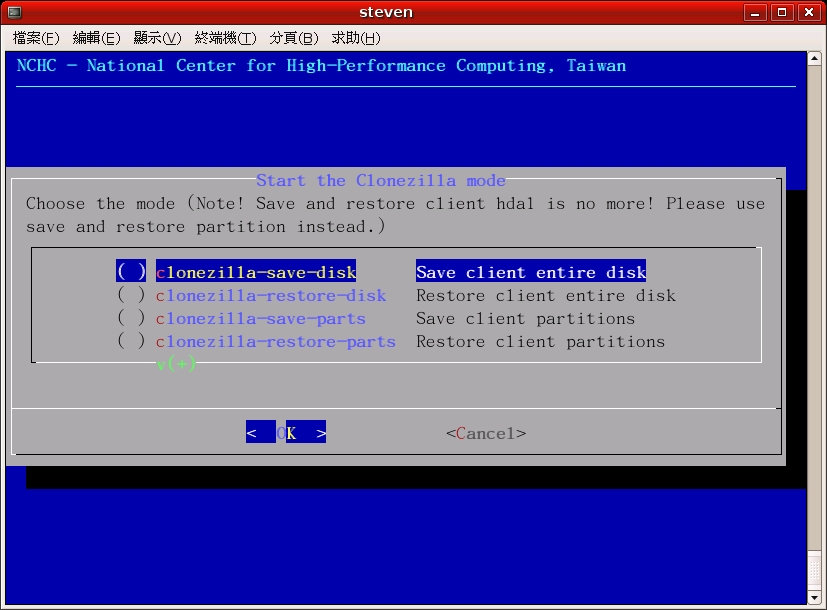

- Install clonzilla on usb for mac mac osx#
- Install clonzilla on usb for mac install#
- Install clonzilla on usb for mac software#
- Install clonzilla on usb for mac password#
- Install clonzilla on usb for mac Pc#
It booted! And it will also now properly boot from CD/DVDs as well. I did an Option boot – hold down the option key on power up. This is what got it working right – so simple, it turns out. Looks like what is happening is that immediately after cloning with CZL, the boot source record(?) – stored in non-volatile ram somewhere(?) – gets messed up and will not boot from ANY source.
Install clonzilla on usb for mac software#
“THIS SOFTWARE COMES WITH ABSOLUTELY NO WARRANTY! USE AT YOUR OWN RISK!”Īnd the cursor just blinking at the start of the next line…Ĭan anyone give me a clue as to what happened, and what I can do to get this mac back in working order? I can get Apple to take of it as it is brand new and under Applecare, and I may have to resort to that but I am curious as to what the heck is going on? When I try to boot from the Clonezilla CD, I get the first six or so lines of the linux bootup text screen, ending with the line:
Install clonzilla on usb for mac install#
When I attempt to boot from either the HD, or from the OSX install DVD it initially seems to start to boot you see the spinning gear under the apple logo, then eventually the apple logo changes into a “forbidden” symbol, i.e.
Install clonzilla on usb for mac mac osx#
Not from the hard drive, or even from the Mac OSX 10.5.6 install DVD, or even the Clonezilla CD. This restore process took about 30 minutes as well.Īfter the restore however, the Mac (that previously booted OSX fine) will not boot up at all. I then booted up another virgin Macbook from the same Clonezilla CD – went through all the appropriate restore disk steps, and again everything appeared to go perfectly. So my strategy was to prep a master and create a disk image directly to a samba server (Win2k3 server on a domain) employing the same steps I use to clone Win pcs…Įverything worked exactly as it does on the PC…I booted the Macbook from the Clonezilla – Live CD, (holding down the C key on boot) specified all the parameters to do a savedisk to a samba server share, and ½ hour later the image was created successfully. I use it in a school environment to help keep the PCs up and running.Īnyway, I am using the latest stable version 1.2.2-26 and attempted to experiment using it to clone a batch of brand new macbooks.
Install clonzilla on usb for mac Pc#
You can now quit Terminal and eject the volume.I have been using Clonezilla for a little while and find it works great cloning Win PC hard drives. When Terminal says that it's done, the volume will have the same name as the installer you downloaded, such as Install macOS Monterey.

After the volume is erased, you may see an alert that Terminal would like to access files on a removable volume.Terminal shows the progress as the volume is erased. When prompted, type Y to confirm that you want to erase the volume, then press Return.Terminal doesn't show any characters as you type your password.

Install clonzilla on usb for mac password#
When prompted, type your administrator password and press Return again.* If your Mac is using macOS Sierra or earlier, include the -applicationpath argument and installer path, similar to the way this is done in the command for El Capitan. Sudo /Applications/Install\ OS\ X\ El\ Capitan.app/Contents/Resources/createinstallmedia -volume /Volumes/ MyVolume -applicationpath /Applications/Install\ OS\ X\ El\ Capitan.app Sudo /Applications/Install\ macOS\ High\ Sierra.app/Contents/Resources/createinstallmedia -volume /Volumes/ MyVolume Sudo /Applications/Install\ macOS\ Mojave.app/Contents/Resources/createinstallmedia -volume /Volumes/ MyVolume Sudo /Applications/Install\ macOS\ Catalina.app/Contents/Resources/createinstallmedia -volume /Volumes/ MyVolume Sudo /Applications/Install\ macOS\ Big\ Sur.app/Contents/Resources/createinstallmedia -volume /Volumes/ MyVolume Sudo /Applications/Install\ macOS\ Monterey.app/Contents/Resources/createinstallmedia -volume /Volumes/ MyVolume If it has a different name, replace MyVolume in these commands with the name of your volume. These assume that the installer is in your Applications folder, and MyVolume is the name of the USB flash drive or other volume you're using. Type or paste one of the following commands in Terminal.Open Terminal, which is in the Utilities folder of your Applications folder.Connect the USB flash drive or other volume that you're using for the bootable installer.


 0 kommentar(er)
0 kommentar(er)
